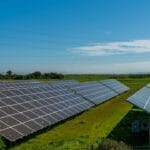Main Points
- By 2024, solar energy is projected to be 35% cheaper, making it more affordable for a wider range of consumers.
- Technological advancements in solar energy are making it more efficient and widely available to people all over the world.
- Installing solar panels at home can lead to energy independence and significant savings on electricity bills.
- Government incentives and policies are in place to encourage the adoption of solar energy.
- The growth of solar energy contributes to job creation and can have a positive impact on local communities.
Why Solar is Leading the Charge in Green Energy
Think of the sun as a powerhouse that never sends a bill. It’s up there, sending free energy our way, and all we need to do is catch it. That’s exactly what solar panels do, and they’re getting better at it every day. But why is solar energy leading the green revolution? Well, it’s clean, it’s getting cheaper, and it’s pretty much everywhere.
Let’s simplify this. Solar energy is green because it doesn’t emit any pollutants into the atmosphere, unlike the combustion of fossil fuels. What about the cost? Over the last ten years, the price of solar panels has dropped dramatically, making it a viable choice for a larger number of individuals. Furthermore, the sun does not discriminate – it shines on everyone. This means that solar power can be utilized in a variety of locations, from a tiny hamlet to a busy metropolis.
The Sun’s Infinite Power
The sun is a natural nuclear reactor, emitting energy packets known as photons, which make the 93-million-mile journey to Earth in about 8.5 minutes. Enough photons hit our planet every hour to theoretically meet global energy needs for a whole year. Now that’s what I call power!
- In just an hour, the sun provides more energy to the earth than we consume in a whole year.
- Solar panels convert this energy into electricity without the need for moving parts or emissions.
- This energy can power anything from small devices to whole cities.
Most importantly, as long as the sun keeps shining, this potential is infinite. That means we have a sustainable energy source that could last us for billions of years. In addition, it’s a way to escape the finite fossil fuels that are becoming harder to extract and are damaging to our planet.
Significant Advances in Solar Technology
- There have been significant improvements in solar photovoltaic (PV) technology, with the efficiency rates of panels on the rise.
- Concentrated solar power (CSP) is another technology showing great promise, especially for utility-scale projects.
- Energy storage solutions are developing, enabling the use of solar energy even when the sun is not out.
As the technology improves, solar panels are no longer just for rooftops. They are appearing in a variety of places, from building facades to car roofs. And as battery technology improves, we can store the energy from sunny days for use on rainy days. This is a game-changer because it addresses one of the biggest challenges of solar energy: what to do when it’s dark.
So, each advancement in solar technology isn’t just about making it simpler to capture the sun’s energy; it’s about making sure solar power is a dependable part of our energy mix. This is vital as we begin to rely on it more heavily.
Comprehending the Solar Surge
What’s causing this boom in solar energy? It’s a combination of improved technology, declining costs, and an increasing awareness that we must protect our environment. People are recognizing the advantages of solar power, and they’re embracing it.
The Financial Aspect of Solar Energy
As the saying goes, money talks, and it’s currently advocating for solar power as a wise investment. The expense of installing solar has plummeted by over 70% since 2010, and it’s predicted to continue to drop. This is due to the fact that the production of solar panels is becoming less expensive and the panels themselves are becoming more efficient.
However, it’s not solely about the initial investment. Solar panels can help reduce your electricity costs and can potentially increase your property’s value. Additionally, there are typically incentives such as tax credits and rebates which can make the transition to solar power even more enticing.
Environmentally Friendly: A Greener Option
Solar energy is a game-changer for the environment. It doesn’t contaminate the air or water, and it doesn’t add to global warming. This is critical because every decision we make now will impact our future.
Solar panels silently produce electricity without emitting any pollutants. This allows us to fuel our lives without polluting our environment. As we increase our use of solar energy, we decrease our dependence on fossil fuels, which contributes to the slowing of climate change.
Consider it like this: every solar panel is a small (or sometimes large) warrior in the battle against pollution. And it’s a battle we must win.
Progress in Solar Energy Storage
The more we rely on solar power, the more important it becomes to answer the question, “What happens when the sun goes down?” That’s where progress in energy storage comes in. Contemporary battery technology is a game-changer, ensuring that we can keep the lights on even when the sun isn’t up.
Advancements in Battery Technology
There have been significant advancements in battery technology, which is a key component of solar power. Modern batteries are more efficient, longer-lasting, and more cost-effective than ever before. This includes lithium-ion batteries that can store solar energy during the day and provide power to homes during the night. Improvements in battery materials, such as the use of lithium iron phosphate, are making batteries safer and more eco-friendly as well.
Smart Grids and Solar Integration
However, the equation is not just about energy storage; it’s about its intelligent use. Here’s where smart grids come into play. These are electrical networks that employ digital technology to control energy flow. When solar panels generate surplus electricity, it can be directed back into the grid, essentially transforming your home into a small power plant.
Intelligent power grids contribute to energy conservation by maintaining equilibrium between supply and demand. They have the ability to identify where power is most required and distribute it as needed, minimizing waste and ensuring that your solar panels are always having the greatest effect.
Therefore, with improved batteries and more intelligent grids, solar power is more dependable than ever. As a result, we can rely on it as a substantial portion of our energy supply.
Government Incentives and Policies
Switching to solar can be a significant change. However, there are numerous incentives available to facilitate this transition. Governments worldwide are providing attractive deals to motivate individuals to adopt solar energy.
For example, in the U.S., the federal government provides a tax credit for solar energy systems. Plus, many states offer extra incentives, such as rebates or programs that compensate you for the surplus energy your panels generate.
Solar Subsidies at Federal and State Levels
The solar investment tax credit (ITC) at the federal level has significantly contributed to the growth of solar energy in the U.S. It enables you to subtract a portion of your solar energy system installation costs from your federal taxes. Plus, it’s not a one-time offer; you can claim it every year you qualify.
Depending on the state, you might be eligible for a variety of incentives like tax credits, cash rebates, property tax exemptions, or even free or reduced cost solar panels for those with low incomes. It’s definitely worth looking into what’s available in your area.
Getting to Know Net Metering
Net metering is yet another policy that is giving solar a boost. It’s a way of billing that gives credits to owners of solar energy systems for the electricity they contribute to the grid. So, if your solar panels produce more energy than you consume, you can send it back to the grid and receive credits. This can greatly reduce your electricity costs – or even completely wipe them out.
Essentially, net metering can transform your solar panels into a money-making machine, and that’s a pretty cool thing.
How Solar Energy Benefits Communities
Solar energy isn’t just about reducing your electric bill or helping the environment. It’s about the potential for positive change it can bring to communities. Local solar initiatives can unite communities, provide jobs, and even increase energy access in the areas that need it most.
Success Stories of Local Solar Initiatives
Let’s consider community solar gardens. These are communal solar power plants where anyone from the community can purchase or rent a “plot.” This is an ideal solution for individuals who are unable to install solar panels on their own homes, such as renters or those with roofs that are shaded.
Not only do these projects supply clean energy, but they also build stronger community ties. Individuals who may have never spoken to one another are now uniting to enjoy the advantages of solar power.
Solar’s Role in the Economy and Employment
When it comes to generating jobs, the solar industry is a force to be reckoned with. Solar jobs are growing at a rate much faster than the general U.S. economy. The solar industry, from the manufacturing of the panels to their installation, is offering well-paying jobs to thousands of individuals.
Moreover, these aren’t ordinary jobs; they’re roles that help foster a greener, healthier world. That’s an accomplishment workers can take pride in when their workday is done.
What’s the Future for Solar Energy?
Solar energy has made great strides, but it’s not done yet. The future is promising, and it’s filled with new technologies and opportunities that could elevate solar to new heights.
Up-and-Coming Solar Energy Trends
Some of the newest trends include solar skins, custom designed wraps that make solar panels blend in with a home’s roof, and floating solar farms that can be installed on bodies of water. There’s even discussion of solar paint, which could turn any surface into a solar panel.
Let’s also consider the potential of solar energy in space. Picture harnessing the power of the sun where it never sets and sending that energy back to Earth. It may seem like the stuff of sci-fi, but it may not be as far off as we think.
Predicting Solar’s Future Path
Given these developments, it’s obvious that the expansion of solar energy isn’t going to slow down in the near future. Prices will keep falling, technology will improve further, and solar will become an increasingly important part of our lives.
So, what’s next? If you’re contemplating a switch to solar energy, now is the ideal time. Investigate the incentives available in your area, evaluate your energy requirements, and make the leap toward a more sustainable, environmentally friendly future. Your budget, your community, and the planet will be grateful.
Green energy is more than just a catchphrase; it’s a solid route to a more sustainable future. Solar power, with its impressive developments and rapidly falling prices, is leading this shift. It’s changing how we perceive and utilise energy, bringing us nearer to a greener, more robust power grid. Adopting solar energy isn’t just about taking on new technology; it’s about pledging to a healthier planet and a more sustainable lifestyle.
What’s New in Solar Energy?
There are a lot of exciting things happening in the world of solar energy. One of the coolest new developments is the creation of solar skins. These are photovoltaic cells that are made to look like roof tiles or other surfaces. This makes solar panels blend in better and less noticeable. Another cool thing that’s being worked on is floating solar farms, or ‘floatovoltaics’. These are solar panels that float on the surface of reservoirs and lakes. This is a great way to generate power without using up valuable land.
Yet, the most exciting possibility might be the creation of solar paint. Picture turning any surface into an energy producer with just a splash of paint. Scientists are currently developing a type of paint that can absorb sunlight and convert it into electricity, effectively turning entire structures into solar panels. These emerging trends underscore the inventive spirit propelling the solar industry onward, making solar power more adaptable and ingrained in our everyday lives.
Envisioning the Upcoming Path of Solar
When we gaze into the future, it’s evident that solar energy will keep broadening its scope and influence. The International Energy Agency (IEA) has forecasted that solar power might be the largest provider of electricity worldwide by 2050. This is partly due to constant advancements in the efficiency of solar panels, revolutionary strides in energy storage technology, and supportive policies from governments worldwide. With an unyielding push for innovation and sustainability, the solar industry is set to be a key player in the worldwide shift to green energy.
Common Questions
What is the Cost of Solar Panel Installation?
Over the years, the cost of installing solar panels has significantly reduced, making it more affordable. Homeowners typically spend between $15,000 and $25,000 on a solar panel system before tax credits and incentives. However, the actual cost can vary depending on factors such as the size of your system, where you live, and the type of panels you opt for. Therefore, it is important to do your research and get quotes from different installers to ensure you get the best price.
Is it Possible to Power My Whole House with Solar Energy?
Absolutely, it’s completely feasible to power your whole house using solar energy. The trick is to set up a solar panel system that’s the right size for your energy consumption and to think about integrating battery storage to keep the power on when the sun isn’t out. A home energy audit can assist in figuring out your energy use and the system size you’ll require. With the correct configuration, you can attain energy self-sufficiency and even generate surplus electricity to sell back to the grid.
How Long Do Solar Panels Last?
Solar panels are designed to be durable and long-lasting. Most panels come with a warranty of 25 to 30 years, but they can continue to generate electricity well beyond that time frame, albeit at slightly reduced efficiency. The lifespan of your solar panels can be influenced by factors such as the quality of the panels, the local climate, and maintenance. With proper care, your solar investment can provide clean energy for decades.
What is the Impact of Weather on Solar Panel Performance?
Even though solar panels require sunlight to produce electricity, they can still operate under cloudy conditions, although their efficiency will be lower. Severe weather events such as snow, hail, or heavy rainfall can temporarily reduce output but rarely result in lasting damage. Solar panels are subjected to rigorous testing to ensure they can withstand severe weather. In warmer climates, panels may be less efficient at extremely high temperatures, but advances in technology are improving their ability to withstand heat.
Do Solar Panels Need Maintenance?
Solar panels don’t need much maintenance. The most important thing is to keep them clean because debris and dirt can block the sun and make them less efficient. Most of the time, the rain will clean the panels for you. But you should also check for damage or things blocking the panels from time to time, and make sure that trees don’t start to shade the panels. Many people who install solar panels also offer maintenance services, and regular checks can help make sure your system works well and lasts a long time.
In summary, solar energy isn’t just a part of the green energy movement; it’s at the forefront of the push for a sustainable future. With the constant progress in technology, policies that are conducive to its growth, and the growing recognition of the advantages of solar power, we are on the brink of a clean energy revolution. The time has come to adopt solar energy and play a role in shaping a future that is brighter, greener, and more resilient.












